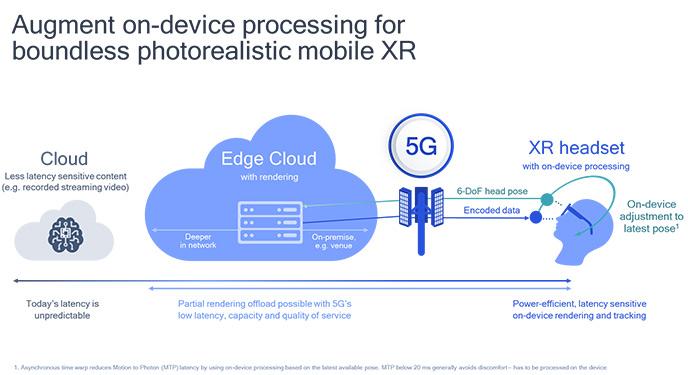
May 28, 2020 – Qualcomm has announced that over-the-air trials for Boundless XR over 5G at both Qualcomm Technologies and Ericsson campuses have been kicked off, initially targeting VR applications for private enterprise networks.
Qualcomm states that the wireless edge transformation, which introduces a new era in distributed computing powered by 5G, on-device processing, and edge cloud processing, is enabling new immersive experiences like boundless XR. Boundless XR distributes processing through a technique known as split rendering where on-device rendering and perception processing is augmented by high-performance edge cloud graphics rendering over a high-capacity low-latency 5G connection. Distributing the processing over 5G can offer the best of both worlds, allowing for boundless mobile XR experiences with photorealistic visuals.
Since first introducing its boundless XR vision less than 2 years ago, Qualcomm states that it has made a lot of progress. At MWC 2019, the company showcased boundless XR over a live 5G network as a proof of concept. At the 2019 Snapdragon Tech Summit, it announced the Qualcomm Snapdragon XR2 Platform — the world’s first 5G-supported XR platform. At Qualcomm’s “What’s Next in 5G” press conference in February 2020, the company unveiled its 5G-enabled XR reference design that delivers an end-to-end boundless XR over 5G solution. The reference design is powered by Snapdragon XR2 and Snapdragon X55 5G Modem-RF System, with native support for 5G mmWave and sub-6 GHz. The reference design was also tested and validated over Ericsson’s 5G network infrastructure.
Qualcomm Technologies has been collaborating with Ericsson to bring boundless XR to commercialization. As part of this collaboration, Ericsson is providing the 5G network infrastructure with its radio network and high-performance distributed cloud native 5G core to deliver low-latency, high-speed wireless connectivity and enhanced XR experiences. Qualcomm Technologies is providing the Snapdragon XR2 5G reference design, which includes the company’s optimized Snapdragon X55 modem and on-device perception and reprojection processing.
The company states that the over-the-air networks being trialed could serve a broad number of use cases, such as the factory of the future, immersive gaming, training, education, healthcare, and retail. As part of the trials, Qualcomm Research, a division of Qualcomm Technologies, Inc., is optimizing the Snapdragon X55 modem for delivering boundless XR at scale. Unlike traditional smartphone eMBB (enhanced Mobile Broadband) traffic, XR traffic requires stringent 5G airlink latencies. Qualcomm is working on 5G airlink optimizations to meet the packet latency targets with sufficient margin. These latency improvements translate to more efficient utilization of spectrum and a larger system capacity, which the company states is essential for scaling boundless XR.
In addition to latency requirements, XR applications, especially in gaming use cases, may have rapid roll, pitch, yaw, and translational user movements that can cause increased packet error rates over the 5G airlink. mmWave beam management on Snapdragon X55 will be validated for rapid user motion. Optimizing modem power is also important for boundless XR due to low latency and high-bandwidth traffic requirements, so Qualcomm Technologies is working with Ericsson to optimize the 5G airlink to reduce end-user power consumption and enhance battery life.
Qualcomm states that its portfolio of end-to-end optimization techniques for XR are well suited to solve the complex system challenges that will enable the mass deployment of boundless XR. The learning from the trials and testbeds will have a tight feedback loop for improving the company’s product roadmap as well as feeding into emerging 3GPP standards, the company states.
Image credit: Qualcomm Technologies
About the author
Sam Sprigg
Sam is the Founder and Managing Editor of Auganix. With a background in research and report writing, he has been covering XR industry news for the past seven years.




